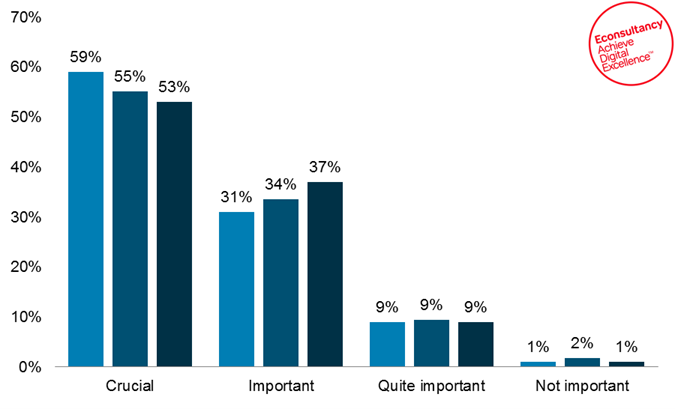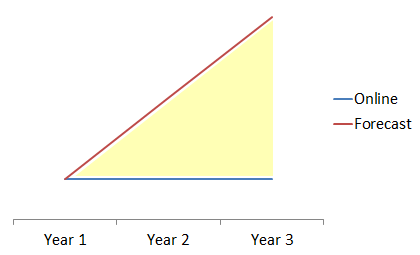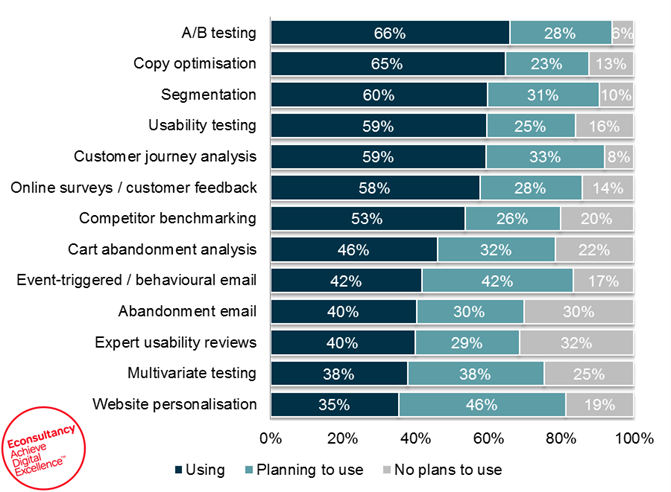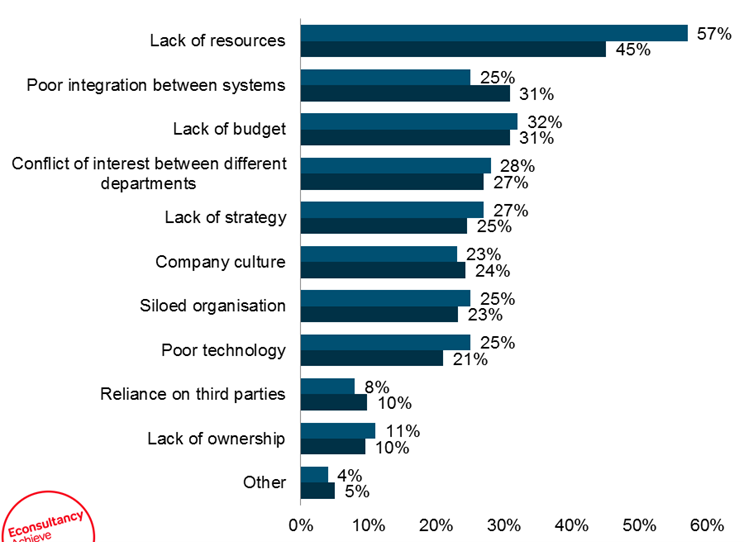Introduction
Conversion Rate Optimisation is now mainstream digital marketing, yet it still seems to lack the budget recognition it needs and deserves. We have 10 years’ worth of data from 10 editions of our CRO Reports (written in conjunction with econsultancy) that consistently make this very point stating that: lack of budget was a key barrier for CRO.
Whether you are already doing CRO or not, this article offers some helpful guidance and considerations we have seen work over the last 10+ years when putting together a business case for CRO.
What is CRO and why is it important?
CRO or Conversion Rate Optimisation, despite its name is not simply about improving the number of users that “convert” across a brands digital presence. By digital presence we mean desktop, mobile, tablet, apps and digital assisted customer journeys. The main objective of CRO is to maximise the potential from the available traffic, for lot’s of businesses this means increasing conversion to sale.
But CRO can, and should, also consider other key metrics such as “average order value” or softer objectives such as “view content A” that will help inform the user and make it easier for them to purchase in store for example (a digital assisted journey). Whatever the metric, it needs to be measurable and relate back to your business model so that you can quantify the improvement and business impact.
CRO is in essence a methodology that is made up of a series of “methods” some of which require technology solutions to make use of them such as AB testing, while other methods require softer skills such as persuasive design for example.
For CRO to be successful as a methodology the culture also needs to be right, therefore CRO is also a framework within which a business can operate to develop a culture that fits, making the application of CRO easier.
To recap, CRO is in essence both a toolkit and a culture, and the better the culture the better the toolkit is applied.
The importance of CRO is evident from the fact that 90% of respondents of CRO Report (figure 1) state CRO to be crucial or important to their overall digital marketing strategy.
Figure 1 How important is conversion rate optimization to your overall digital marketing strategy?
But why is CRO important? There are 2 key reasons that are intrinsically linked:
1. The rise of the customer, a well-known and reasonably well understood concept given we are all customers ourselves and can relate to this shift. Our expectations when it comes to digital have changed, it is more than ever about convenience, choice, efficiency, speed, value for money… i.e. the customer experience. CRO is all about considering the customer first in most cases.
2. Share of customer wallet: loyalty is a tough commodity in today’s digital climate, the customer is ever more fickle, but if brands provide a good customer experience they can dramatically increase their share of the opportunity that is already available to them i.e. existing customers and new/repeat visitors.
In summary CRO is a methodology that is both practical as a toolkit and a framework that a business can adopt to increase revenue from traffic and customers that are already available to it. When well executed CRO drives an iterative perpetual increase in the overall customer experience.
Its importance stems from the fact that it is the most effective way to increase revenues online. It is therefore important that CRO retains a commercial edge and that its application is constantly brought back to the most important business metrics such as revenue, profit, sales and average order value – do not let the “Conversion rate” blur things as an increase in CR combined with a drop in AOV can have an adverse effect on the bottom line.
Why build the business case for CRO?
Every brand “needs” a digital presence today especially those losing out on the high street, the losses suffered on the high street need to be recouped somewhere and that somewhere is online. The fight is now online, to the best customer experience go the spoils.
How to drive more revenue from online?
For the purpose of this article we are going to consider the 3 obvious options that are likely to drive an increase in online revenues:
- Increase the volume of traffic = increase potential to impact options 2 and 3
- Increase the volume of traffic that converts into customers = increase in sales
- Increase net customer retention = increase repeat purchases + average order value
CRO addresses both options 2 and 3 and importantly it offers the potential to tackle them without the need for significant additional budget. Thus making CRO a viable solution to a challenge all businesses face currently no matter who they are. Interestingly it is important first of all to understand the impact of not doing CRO, quantifying this is a good starting place for any business case.
The business impact without CRO?
The easiest approach is to plot a simple a 3 years revenue graph showing the gap between current revenues vs revenue targets your business is aiming to achieve:
First plot current online revenue derived from your key metrics such as: conversion rates, average order values and number of repeat online purchases etc at their current levels. Blue line shows this as a constant and remains flat (obviously).
Second plot on the same graph the revenue targets for your business over the same 3 years. Assuming your business is like most this line will increase.
As figure 2 below shows the gap between the two lines grows exponentially. As a business you can fill the gap one of two ways:
1. Increase the volume of traffic (ideally relevant traffic!) to compensate, but if it has not already, your traffic will plateau and in doing so damage your ability to hit revenue projections.
2. Improve the performance of your metrics to maximise your traffic and hit your revenue projections.
For most mature brands option 1 is no longer available, or of it is, not for much longer. Either way engage your acquisition team to quantify the cost of driving the additional traffic (assuming you can drive the levels needed) to sustain the desired revenue growth. This is the cost the business is willing to pay for the growth forecast; it is a fantastic benchmark to have to hand before even beginning to quantify the business case for CRO.
Figure 2 – online revenue as a constant vs revenue forecasts
How to build the business case for CRO
Whether you are just starting off or looking to increase investment in CRO, there are 3 key steps to follow:
- Assess maturity of CRO
- Define methodology and processes needed
- Identify benefits and calculate ROI
Assess maturity of CRO
CRO requires time, dedication and an understanding that it is a journey that will involve many different areas of a business. The various methods used as shown in figure 3 highlight this fact.
Figure 3. methods used- CRO Report
CRO can include many methods so it is important to understand where a business is in its maturity within each, the main ones to focus on:
- Web Analytics & Customer Segmentation
- User/Customer Experience
- A/B Testing
- Personalisation & Persuasive design
- Web analytics & customer segmentation
It is pretty much impossible to do CRO without web analytics; Google Analytics is an excellent free solution and is widely used so there is no excuse. Companies however often fail to setup GA in such a way, that it is a deemed a reliable and robust source of insight, this should be your starting point.
To gauge how well Analytics is setup and how mature its use is, ask these questions of yourself and the business:
- Have you set up goals and audited your analytics tool setup?
- Are you using segments to drive greater visitor insights?
- Are you using a paid for analytics tool?
- Is the use of analytics to report or do you derive insight?
- User/Customer experience
CRO places significant importance on the customer and their needs and expectations. Getting close to your customers to understand how they react when engaging with your website, app, emails… is vital. Web analytics can point to where a problem is e.g. high bounce rate, but it is very hard to accurately understand why the issue is occurring without UX. As with analytics it is impossible to do CRO without a degree of UX.
Make sure that everyone involved in CRO are encouraged to learn the basic principles of UX. For example, encourage analytics specialists to learn the basics of UX because this will help them frame the data insights around a user journey and user interaction i.e. making the data far more actionable.
To gauge if you have the necessary UX expertise, ask these questions of yourself and the business:
- When was the last time you ran usability testing?
- How often do you run usability testing?
- Are you using personas, key user journeys?
- How much influence does UX have on the strategic thinking of the business?
- A/B testing
A/B testing and CRO are often misinterpreted for one and other, yet while it is nearly impossible to do CRO without the previous 3 it is possible to do it without A/B testing. In fact in some cases it is necessary where a website lacks the traffic or conversion rates to make A/B testing a viable means of optimisation.
That said A/B testing and the proliferation of systems available today such as Adobe Target, AB Tasty, Optimizely to name a few have made testing ubiquitous when it comes to optimisation. So it is very hard to imagine doing CRO without A/B testing, and what really makes the difference is the quality of the tests. And this is where everything starts to come together as one, the analytics and UX area great source of ideas, the design skills help create winning and persuasive variants that can then be tested to see which one performs best. The learnings from the tests then feed back into the insight pool and the process repeats.
To gauge how mature your A/B testing is, ask these questions of yourself and the business:
- Do you run A/B tests?
- How many tests do you run per month?
- Do 60% or more of your tests have a positive impact?
- Are you creating bold tests that are substantiated and supported by evidence?
- Personalisation and persuasive design
Designing for the customer without eroding the business needs is difficult. If CRO was simply the application of the insights derived from UX and analytics things would be a lot easier! The reality is that any business also has its needs, reaching a compromise is what CRO aims to do by interpreting the needs of both the user and the business.
Persuading the user to act in a way that is in line with the business needs is therefore critical to a compromise and for CRO to have a positive commercial impact. Persuasive design and personalisation should be used to achieve this, while personalisation may require a technology solution, persuasive design does not, so start there.
To gauge whether or not you are being persuasive in your designs and/or personalising, ask these questions of yourself and the business:
- Do you include persuasive concepts such as social proof, unique propositions, urgency?
- Do you talk to your best customers differently and in a more personalised manner?
- Do you personalise content at all?
- Which channels do you use personalise content in, email, web…?
Define methodology and processes needed
Once you have assessed how mature the various methods are you need to consider what you are going to need to put in place to execute CRO, this is all about people and processes.
CRO is a journey – it’s a cliché but true! Be very honest about the “journey” ahead and do not mismanage the expectations of key sponsors and the business. Building a business case is not purely about revenue, the resource requirements will be significant. In fact one of the biggest barriers is a lack of dedicated resource, even more telling is the fact that 7 of the top 10 barriers are all related to people and processes.
Before building the business case for CRO understand your business and its aptitude to change, be sure that your business case can and will drive the change you feel is needed.
Figure 4. Biggest barriers to CRO – CRO Report
Resource considerations/challenges:
- Buy in – pulling people away from BAU
- Getting buy in from peers and other teams
- Lack of single strategy that straddles multiple divisions
- Communicating across the business
- Delivering CRO
- Single points of failure due to embryonic state of CRO
- Skills gaps – outsource or internal development
- Competing for skilled resource e.g. developers
- Training
- Recognition and cultural shift
- Reporting and buy in from senior members
- Find a senior sponsor (if not you)
For the purpose of your business case, focus on 3 key areas:
People and Knowledge:
- How many CRO members do you have?
- What skills do you need: UX, analytics, design, developers, business/commercial skills
- Are you learning from blogs, white papers, conferences?
- Are you using a specialist CRO partner to help you?
Overall Strategy:
- Have you created a CRO strategy and process yet?
- Do you have all the necessary technology needed to correctly execute your strategy?
- How do you expand CRO?
- Are you prioritising CRO on likely impact and ease of setup?
- Have you identified all the barriers to CRO?
Budget:
- Is there a CRO budget?
- How will resource be paid for across the various divisions?
- If a partner is needed how much budget is needed?
- What and how is budget secured for technology (if it is needed)?
And finally does CRO have a proven ROI or perceived value? This last point is actually what makes up most business cases, and while it is of course incredibly important you must consider everything else as well.
Identify benefits and calculate ROI
It is time to dust off the benchmark research you did earlier with the simple revenue graph showing the gap between revenues and projections. Using this start to quantify CRO as an alternative solution to simply investing more in driving greater volumes of traffic to your website.
Benefit driven approach
Always frame the business case around key business relevant benefits, list the benefits of doing CRO and decide which ones are most likely to resonate with your audience:
- Makes use of the existing opportunity
- Traffic
- Customers
- Leverage existing budget
- Helps you better understand your customers
- Has longevity as a methodology
- Reduce customer acquisition costs
- Increase lifetime value
- Increase sales
- Increase average order value
Sense of urgency:
Next identify when CRO must be in place by, to do this pinpoint your traffic ceiling (you are probably already there) and evaluate competitors to benchmark their traffic volumes. If you are already on a par with better performing competitors (in terms of traffic) then implementing CRO should be seen as a pressing urgent priority for the business.
ROI
There are several ways to quantify the ROI of doing CRO, but it is important to focus efforts on 2 key areas:
1. Uplift in key metrics: Conversion rate & average order value for example
2.CRO improves performance of acquisition budget
Uplift in key metrics:
Build a model using your analytical data that shows the revenue impact of uplift in a key metric, in this example we have used conversion rates – by applying CRO we are confident we can generate an uplift of 3%:
CRO improves performance of acquisition budget
If you cannot source further budget or do not yet have a dedicated budget for CRO then you need to think about where it can be “borrowed” from. By using the term borrowed we assume that you will repay the budget in some capacity. The acquisition budget is a good place to start!
By virtue of improving conversion rates, the cost of customer acquisition should fall. Show how over time this cost falls if acquisition remains the same and conversion rates increase in line with the model you have built in the previous point. Quantify the cost saving generated as a consequence of CRO in terms of “customer acquisition cost” – use this to show 2 things:
1. When the budget taken from acquisition will effectively be repaid
2. That CRO essentially unlocks the budget to sustain its own growth and development.
Conclusion
Remember a business case is not just an ROI, it does often prove to be the catalyst but without thinking through the resource and cultural elements that are needed to make CRO a real success the business case will not deliver the change you hope it will.










